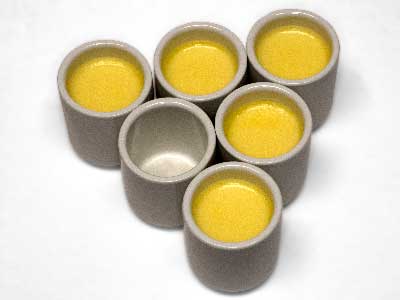January 26, 2015
Amuse-Bouche

flan aux œufs et fromage
(cheese custard)
The denaturing of protein and its subsequent crosslinking is fundamental to cooking. Every time you prepare a dish of scrambled eggs, that’s what you’re doing. You mechanically denature some its many proteins when you beat the egg. Then, as the egg warms in the pan, thermal denaturation occurs. At about 60 °C (140 °F), the proteins begin to crosslink and form a gel that traps water droplets in a newly created protein mesh. If overcooked, the protein mesh tightens, and some of the water is squeezed out. How you control the heating of the scrambled eggs determines if they have a fine, small, medium, or large curd, and whether they’re dry or wet in appearance. Overcook them, and the scrambled eggs will sit in a puddle of water.
Diluting a beaten egg with a liquid such as water, broth, milk, or cream prevents the coagulated gel from being as firm. We generally refer to the mixture as a custard, and the dilution determines whether the finished product forms a solid gel or a thick liquid. Whether it’s the filling for a savory quiche or a sweet pie or the mix for ice cream, it’s all custard. The dilution and additives varies, but the mixture is still a custard.
Plain savory custards are not particularly common in the west, but both Chinese and Japanese cooking have long traditions of preparing steamed, savory custards. Towards the end of my Chinese-cooking days I prepared zhēngshuǐ-dàn (蒸 水 蛋) from a recipe I found in a modern book of Ming dynasty (1368-1644) recipes. (It was the only recipe in the book that I could prepare.) When I switched Asian cultures in the early 1990s, I ate the Japanese version chawan-mushi (茶碗蒸し) on a number of occasions, but I never appreciated it. One quality that all these custards shared was that they were overcooked. As the custard was broken with a spoon, the mixture would become soupy from the loose liquid released by the overcooked gel.
In February, 2011, my wife and I ate at Morimoto in Napa. We ordered the omikase menu. One of the dishes we were served was a foie gras chawan-mushi. Unlike the other savory egg custards I had previously eaten, this one was perfectly smooth and not overcooked. At the time it was not the highlight of the meal, but today it is the dish I remember most. By the time I finally got around to making a chawan-mushi, foie gras had become illegal in California.
Most preparations are made with dashi as the liquid, but I was looking for a broth with more flavor. I tried other high umami broths such as a porcini mushroom broth, but the final result wasn’t particularly pleasant. I settled on a broth made from parmesan cheese that produced a silky smooth custard with a pronounced parmesan flavor.
The secret of a super successful chawan-mushi-style custard is to not overcook it. I achieve that by cooking the dish in a water bath that is just hot enough to form the gel, but not hot enough to squeeze any water out of it. I use a temperature-controlled non-circulating water bath for this. After filling, each custard cup is covered tightly with a single layer of plastic wrap. A rubber band is used to hold the plastic in place during the cooking. The custard cups are placed in a small, water-filled baking pan to prevent them from falling over.
The recipe below will produce about six portions of the finished custard and a double batch of cheese water. My serving cups hold 45 ml (3 T) when filled to the brim.
225 g (8 oz)
Argentine parmesan reggianito zerto, or similar cheese, grated
450 ml (2 c)
filtered water
1 large
egg
1. Combine the cheese and water in a saucepan over medium heat. Bring to a boil, reduce heat, and simmer for 10 minutes. Strain the contents of the saucepan, reserving the liquid and discarding the solids.
2. At this point the cheese water is mostly liquid with a small amount of very tiny particles. The particles can either be filtered out or left in. If left in, be sure to stir the cheese water before measuring and again before cooking.
3. Combine the egg with 160 ml (2⁄3 c) of the cheese water in a beaker or tall glass. Mix briefly but thoroughly with an immersion blender. Rest the mixture in your refrigerator until bubbles are gone. I usually do this overnight.
4. The next day, if the mix has separated, stir gently with a chopstick. Slowly pour the mixture into the custard cups. Cover each with plastic wrap secured with a rubber band.
5. Cook in still, 77°C (170°F) water until set, about 80 minutes. One-by-one, lift the custard cups from the water bath. Carefully remove the plastic wrap so the condensation doesn’t fall on the custard.
6. Eat warm for more flavor, or let cool for more convenience. To reheat, bring a shallow saucepan of water to a simmer. Remove the pan from the heat, and place the custard cups in the hot water for 10 to 15 minutes.
© 2015 Peter Hertzmann. All rights reserved.
